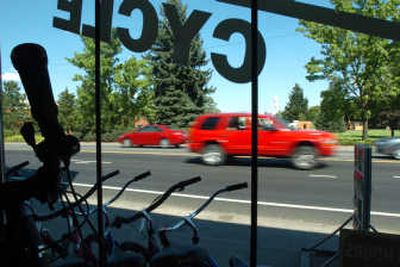Future of Argonne

Addressing an almost full house during a special Tuesday night meeting, Millwood Councilman Kevin Freeman asked residents to seek ways to make Argonne Road a benefit to the town.
“When you’re making your comments tonight think of Argonne the way you would like to see Argonne,” Freeman said. “Engineer a solution to be able to move through and enjoy the benefits of our community and make this our town.”
During the two-hour meeting, residents offered visions and passionate opinions about the future of their town’s main thoroughfare.
Town signage, speed-limit reduction, left-turn lanes, a pedestrian bridge, corridor beautification and synchronized traffic signals were ideas expressed by local residents.
“We received good input from the town of Millwood,” said Mark Brower, W&H Pacific project manager and engineer. “It was a very good meeting.”
Ted Praast, a Millwood resident since 2003, suggested incorporating an idea similar to Silicon Valley in California. Synchronized traffic signals allow traffic to move through the Valley quickly.
“What I think we really want to do is get people through with little delay as possible,” said Praast. “They can shoot right on through, spend as little time as possible, and pollute us as little as possible.”
Other residents expressed a desire to identify Millwood with signage at the north and south entrances on Argonne, along with beautification and greenery.
“I would love to see an entrance into Millwood,” said Michelle Rasmussen. “When you have an entrance and something that changes the view from what you’ve been driving on it reminds people they are coming into a town and to slow down.”
Mayor Dan Mork, Brower and Katherine Casseday, manager of Mirai Traffic Engineering of Kirkland, Wash., presented study findings and fielded questions. Brower and Casseday presented a summary of their baseline-conditions report compiled from a traffic study conducted in May.
The study is in response to a citizen survey conducted in 2006, identifying Argonne Road as a primary concern. Argonne traffic, estimated to increase to more than 50,000 vehicles daily in the next 10 years, is one of the two main north-south arterials in Spokane County. The other main arterial is Division Street.
The primary objectives of the study are to manage traffic, improve safety, improve livability for neighborhoods within the corridor, foster the local economy and enhance environmental quality.
According to Casseday, the study shows 33,000 vehicles travel Argonne daily. More than 90 percent of vehicular traffic are transient, nonresident vehicles traveling through the town.
Another key component of the study identified a large amount of heavy freight movement along the corridor.
“One out of every six vehicles on Argonne Road is classified as a truck,” said Brower in reference to the number of vehicles with two rear axles making the road a critical freight operating corridor.
On Monday night before the public meeting, the town held a special stakeholders meeting to gather input from outside interests such as Spokane County, city of Spokane Valley, Millwood business owners and the Spokane Valley Fire Department. West Valley School District and the Sheriff’s Department were unable to attend.
Incorporating comments from the stakeholders and residents, W&H plans to develop the future vision of the corridor. W&H and Millwood anticipate an opportunity for public comment on the proposed vision during a special mid-October meeting. W&H hopes to complete the strategic plan by end of the year.
The town wants to incorporate some of W&H’s solutions into the Argonne reconstruction and rehabilitation project set for 2008. The viability of these solutions is uncertain. Funding for the Argonne project comes from a 2008 Spokane Regional Transportation Council $1.3 million grant.